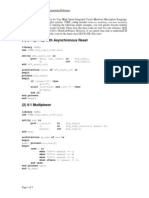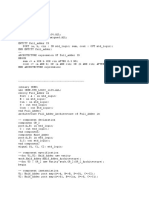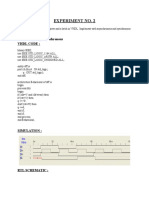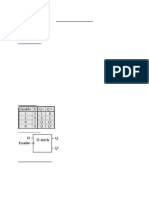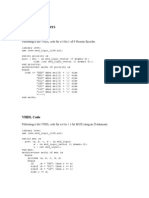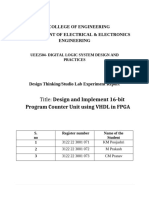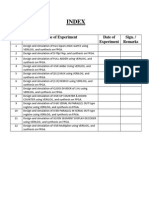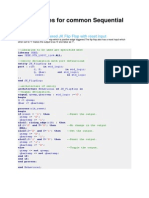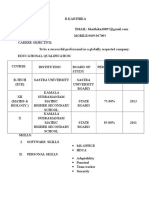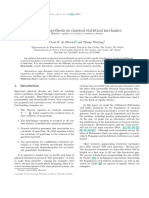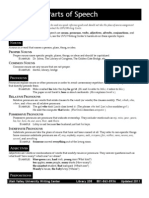VHDL Processes: Cwru Eecs 318
VHDL Processes: Cwru Eecs 318
Uploaded by
KarThikCopyright:
Available Formats
VHDL Processes: Cwru Eecs 318
VHDL Processes: Cwru Eecs 318
Uploaded by
KarThikOriginal Description:
Original Title
Copyright
Available Formats
Share this document
Did you find this document useful?
Is this content inappropriate?
Copyright:
Available Formats
VHDL Processes: Cwru Eecs 318
VHDL Processes: Cwru Eecs 318
Uploaded by
KarThikCopyright:
Available Formats
EECS 318 CAD
Computer Aided Design
LECTURE 8:
VHDL PROCESSES
Instructor: Francis G. Wolff
wolff@eecs.cwru.edu
Case Western Reserve University
This presentation uses powerpoint animation: please viewshow
2-to-1 Multiplexor: and Datapath multiplexor
a
behavioral
Y
b
n
n
0
n
Datapath
Datapathis
isnnbits
bitswide
wide
WITH
WITHssSELECT
SELECT
YY<=
<=aa WHEN
WHEN0,
0,
bb WHEN
WHENOTHERS;
OTHERS;
WITH
WITHss SELECT
SELECT
YY<=
<= aaWHEN
WHEN0,
0,
bb WHEN
WHENOTHERS;
OTHERS;
Where
Whereis
isthe
the difference?
difference?
Generic 2-to-1 Datapath Multiplexor Entity
a
LIBRARY IEEE;
USE IEEE.std_logic_1164.all;
USE IEEE.std_logic_arith.all;
n
n
0
1
ENTITY Generic_Mux IS
S
GENERIC (n: INTEGER);
PORT (Y:
OUT std_logic_vector(n-1 downto 0);
a:
IN
std_logic_vector(n-1 downto 0);
b:
IN
std_logic_vector(n-1 downto 0);
S:
IN
std_logic_vector(0 downto 0)
);
END ENTITY;
Generic 2-to-1 Datapath Multiplexor Architecture
ARCHITECTURE Generic_Mux_arch OF Generic_Mux IS
BEGIN
WITH S SELECT
Y <= a WHEN "1",
b WHEN OTHERS;
END ARCHITECTURE;
CONFIGURATION Generic_Mux_cfg OF Generic_Mux IS
FOR Generic_Mux_arch
END FOR;
Configurations
Configurationsare
are
END CONFIGURATION;
require
requirefor
forsimulation
simulation
Structural SR Flip-Flop (Latch)
R
Q
Q
R
0
0
1
1
NAND
S Qn+1
0 U
1 1
0 0
1 Qn
ENTITY Latch IS
PORT(R, S: IN std_logic; Q, NQ: OUT std_logic);
END ENTITY;
ARCHITECTURE latch_arch OF Latch IS
BEGIN
Q
<= R NAND NQ;
NQ
<= S NAND Q;
END ARCHITECTURE;
Inferring Behavioral Latches: Asynchronous
Sensitivity
Sensitivitylist
list of
of signals:
signals:
Every
Everytime
timeaachange
changeof
of
state
stateor
orevent
event occurs
occurson
on
these
thesesignals
signalsthis
this
process
processwill
willbe
becalled
called
NAND
R S Qn+1
R
Q
0 0 U
0 1 1
1 0 0
Q
S
1 1 Qn
ARCHITECTURE Latch2_arch OF Latch IS Sequential
Sequential
Statements
BEGIN
Statements
PROCESS (R, S) BEGIN
IF R= 0 THEN
Q <= 1; NQ<=0;
ELSIF S=0 THEN
Q <= 0; NQ<=1;
END IF;
END PROCESS;
END ARCHITECTURE;
Gated-Clock SR Flip-Flop (Latch Enable)
S
Q
LE
Q
R
ARCHITECTURE Latch_arch OF GC_Latch IS BEGIN
PROCESS (R, S, LE) BEGIN
IF LE=1 THEN
IF R= 0 THEN
Q <= 1; NQ<=0;
ELSIF S=0 THEN
Q <= 0; NQ<=1;
END IF;
END IF;
END PROCESS;
END ARCHITECTURE;
Inferring D-Flip Flops: Synchronous
Notice
Noticethe
theProcess
Process
does
does not
notcontain
contain D:
D:
ARCHITECTURE Dff_arch OF Dff IS PROCESS(Clock,
PROCESS(Clock,D)
D)
BEGIN
Sensitivity
Sensitivitylists
lists
contain
contain signals
signalsused
used
in
inconditionals
conditionals(i.e.
(i.e. IF)
IF)
PROCESS (Clock) BEGIN
IF ClockEVENT AND Clock=1 THEN
Q <= D;
END IF;
END PROCESS;
END ARCHITECTURE;
ClockEVENT
ClockEVENTis
iswhat
what
distinguishes
distinguishes aaDDFlipFlip
FlipFlipfrom
fromaaLatch
Latch
Inferring D-Flip Flops: rising_edge
ARCHITECTURE Dff_arch OF Dff IS BEGIN
PROCESS (Clock) BEGIN
IF ClockEVENT AND Clock=1 THEN
Q <= D;
Alternate
Alternateand
and
END IF;
more
morereadable
readableway
wayis
is
END PROCESS;
to
touse
usethe
the
END ARCHITECTURE;
rising_edge
rising_edgefunction
function
ARCHITECTURE dff_arch OF dff IS BEGIN
PROCESS (Clock) BEGIN
IF rising_edge(Clock) THEN
Q <= D;
END IF;
END PROCESS;
END ARCHITECTURE;
Inferring D-Flip Flops: Asynchronous Reset
ARCHITECTURE dff_reset_arch OF dff_reset IS BEGIN
PROCESS (Clock, Reset) BEGIN
IF Reset= 1 THEN -- Asynchronous Reset
Q <= 0
ELSIF rising_edge(Clock) THEN --Synchronous
Q <= D;
END IF;
END PROCESS;
END ARCHITECTURE;
Inferring D-Flip Flops: Synchronous Reset
PROCESS
PROCESS(Clock,
(Clock,Reset)
Reset) BEGIN
BEGIN
IF
IFrising_edge(Clock)
rising_edge(Clock) THEN
THEN
Synchronous
Reset
Synchronous
Reset
IF
IFReset=1
Reset=1THEN
THEN
Q
Synchronous
Q <=
<= 0
0
Synchronous FF
FF
ELSE
ELSE
Q
Q <=
<= D;
D;
END
ENDIF;
IF;
END
ENDIF;
IF;
END
ENDPROCESS;
PROCESS;
PROCESS
PROCESS(Clock,
(Clock,Reset)
Reset) BEGIN
BEGIN
Asynchronous
AsynchronousReset
Reset
IF
IFReset=1
Reset=1THEN
THEN
Synchronous
Synchronous FF
FF
Q
Q <=
<= 0
0
ELSIF
ELSIF rising_edge(Clock)
rising_edge(Clock) THEN
THEN
Q
Q <=
<= D;
D;
END
ENDIF;
IF;
END
ENDPROCESS;
PROCESS;
D-Flip Flops: Asynchronous Reset & Preset
PROCESS
PROCESS(Clock,
(Clock,Reset,
Reset, Preset)
Preset) BEGIN
BEGIN
IF
IFReset=1
Reset=1 THEN
THEN--highest
--highestpriority
priority
Q
Q <=
<= 0;
0;
ELSIF
ELSIF Preset=1
Preset=1 THEN
THEN
Q
Q <=
<= 0;
0;
ELSIF
ELSIF rising_edge(Clock)
rising_edge(Clock) THEN
THEN
Q
Q <=
<= D;
D;
END
ENDIF;
IF;
END
ENDPROCESS;
PROCESS;
RTL Multi-cycle Datapath: with controller
PCWriteCond
PCSource
PCWrite
ALUOp
Outputs
IorD
ALUSrcB
MemRead
ALUSrcA
Control
MemWrite
RegWrite
MemtoReg
Op
RegDst
IRWrite
[5 0]
26
Instruction [25 0]
PC
0
M
u
x
1
Instruction
[31-26]
Address
Memory
MemData
Write
data
Instruction
[25 21]
Read
register 1
Instruction
[20 16]
Read
Read
register 2 data 1
Registers
Write
Read
register data 2
Instruction
[15 0]
Instruction
register
Instruction
[15 0]
Memory
data
register
0
M
Instruction u
x
[15 11]
1
0
M
u
x
1
B
4
16
Sign
extend
32
Shift
left 2
Jump
address [31-0]
Zero
ALU ALU
result
0
1 M
u
2 x
3
ALU
control
Instruction [5 0]
Register
RegisterTransfer
TransferLevel
Level(RTL)
(RTL)View
View
ALUOut
1 u
x
PC [31-28]
0
M
u
x
1
Write
data
Shift
left 2
28
CPU controller: Finite State Machine
ALUzero
PCWriteEnable
PCWriteCond
PCWrite
MemRead
MemWrite
IorDMux FSM
IRWrite
Clock Reset
PCSourceMux
ALUOp
ALUSrcAMux
ALUSrcBMux
RegWrite
RegDstMux
MemtoReg
IRopcode
CPU Controller: Entity
ENTITY cpu_controller is PORT(
CLK, RST
:IN std_logic;
IRopcode
:IN std_logic_vector(5 downto 0);
ALUzero
:IN std_logic;
PCWriteEnable
:OUT std_logic;
PCSourceMux
:OUT std_logic_vector(1 downto 0);
MemRead, MemWrite :OUT std_logic;
IorDMux
:OUT std_logic;
IRWrite
:OUT std_logic;
RegWrite
:OUT std_logic;
RegDstMux
:OUT std_logic;
MemtoRegMux
:OUT std_logic;
ALUOp
:OUT std_logic_vector(2 downto 0)
ALUSrcAMux
:OUT std_logic;
ALUSrcBMux
:OUT std_logic_vector(1 downto 0);
); END ENTITY;
CPU controller: R-Format State Machine
Cycle 1 Cycle 2
R-Format
Clock=1
Ifetch
Reg/Dec
Exec
Decode
Wr
Clock=1
Exec
Rtype
Fetch
Clock=1
Cycle 3 Cycle 4
Write
Rtype
Clock=1
CPU Controller: Current State Process
ARCHITECTURE cpu_controller_arch OF cpu_controller IS
TYPE CPUStates IS (Fetch, Decode, ExecRtype, WriteRtype);
SIGNAL State, NextState :CPUStates;
BEGIN
PROCESS (State) BEGIN
CASE State IS
WHEN Fetch=> NextState <= Decode;
WHEN Decode
=> NextState <= ExecRtype;
WHEN ExecRtype => NextState <= WriteRtype;
WHEN WriteRtype => NextState <= Fetch;
WHEN OTHERS => NextState <= Fetch;
END CASE;
END PROCESS;
CPU controller: NextState Clock Process
PROCESS (CLK, RST) BEGIN
IF RST='1' THEN -- Asynchronous Reset
State <= Fetch;
ELSIF rising_edge(CLK) THEN
State <= NextState;
END IF;
END PROCESS;
END ARCHITECTURE;
T1 Fetch: State machine
Cycle 1 Cycle 2
Start
R-Format
Ifetch
Cycle 3 Cycle 4
Reg/Dec
MemRead=1,
MemRead=1, MemWrite=0
MemWrite=0
IorD=1
(MemAddrPC)
IorD=1
(MemAddrPC)
IRWrite=1
(IRMem[PC])
IRWrite=1
(IRMem[PC])
ALUOP=ADD
ALUOP=ADD (PC4+PC)
(PC4+PC)
ALUSrcA=0
ALUSrcA=0 (=PC)
(=PC)
ALUSrcB=1
ALUSrcB=1 (=4)
(=4)
PCWrite=1,
PCWrite=1,PCSource=1
PCSource=1(=ALU)
(=ALU)
RegWrite=0,
RegWrite=0,
RegDst=X,
RegDst=X, MemtoReg=X
MemtoReg=X
Instruction Fetch
Exec
Wr
Decode
Exec
Write
Reg
T1 Fetch: VHDL with Moore Output States
MemRead=1,
MemRead=1, MemWrite=0
MemWrite=0
PROCESS (State) BEGIN
IorD=1
(MemAddrPC)
IorD=1
(MemAddrPC)
CASE State IS
IRWrite=1
(IRMem[PC])
IRWrite=1
(IRMem[PC])
WHEN Fetch =>
ALUOP=ADD
ALUOP=ADD (PC4+PC)
(PC4+PC)
NextState
<= Decode;
ALUSrcA=0
ALUSrcA=0 (=PC)
(=PC)
ALUSrcB=1
MemRead
<= '1';
ALUSrcB=1 (=4)
(=4)
PCWrite=1,
PCWrite=1,PCSource=1
PCSource=1(=ALU)
(=ALU)
MemWrite
<= '0';
RegWrite=0,
RegWrite=0,
IorD
<= '1'
RegDst=X,
RegDst=X, MemtoReg=X
MemtoReg=X
IRWrite
<= '1';
Instruction Fetch
ALUOp
<= "010;
--add
ALUSrcAMux <= '1';
--PC
'D'
'D'for
for Dont
DontCare
Care
ALUSrcBMux <= "01";
--4
PCWriteEnable<= '1';
PCSourceMux <= "00"; --ALU (not ALUOut)
RegWrite
<= '0';
RegDstMux
<= 'D'; MemtoReg <= 'D';
VHDL inferred Latches: WARNING
In VHDL case statement
The same signal must be defined for each case
Otherwise that signal will be inferred as a latch
and not as combinatorial logic!
For example,
Even though RegDstMux <= 'D' is not used
and was removed from the Decode state
This will result in a RegDstMux
being inferred as latch not as logic
even though in the WriteRtype state it is set
Assignment #3: CPU Architecture design (1/3)
Cyber Dynamics Corporation (18144 El Camino Real, SVale
California) needs the following embedded model 101
microprocessor designed by Thursday October 5, 2000 with
the following specifications
16 bit instruction memory using ROM
8 bit data memory using RAM
There are eight 8-bit registers
The instruction set is as follows
All Arithmetic and logical instructions set a Zero one-bit flag
(Z) based on ALU result
add, adc, sub, sbc set the Carry/Borrow one-bit Flag (C)
based on ALU result
Assignment #3: CPU Architecture design (2/3)
Arithmetic and logical instructions
add $rt,$rs
#$rt = $rt +$rs; C=ALUcarry; Z=$rt
adc $rt, $rs
#$rt = $rt +$rs+C; C=ALUcarry; Z;
sub $rt, $rs
#$rt = $rt - $rs; C=ALUborrow; Z;
sub $rt, $rs
#$rt = $rt - $rs - borrow; C; Z;
and $rt, $rs
#$rt = $rt & $rs;
C=0; Z=$rt;
or $rt, $rs
#$rt = $rt | $rs;
C=0; Z=$rt;
xor $rt, $rs
#$rt = $rt ^ $rs;
C=1; Z=$rt;
Other Instructions continued):
lbi
$r, immed #$r = immediate
lbr
$rt,$rs
#$rt = Mem[$rs]
lb
$r, address #$r = Mem[address]
stb $r, address #Mem[address]=$r
bz
address
#if zero then pc=pc+2+addr
bc
address
#if carry then pc=pc+2+addr
j
address
#pc = address
jr
$r
#pc = $r
Assignment #3: CPU Architecture design (2/3)
(1a) Design an RTL diagram of the model 101 processor and
(1b) Opcode formats and
(1c) Opcode bits of a Harvard Architecture CPU (determine
your own field sizes).
(1d) What is the size of the Program Counter?
(2) Write the assembly code for a 32 bit add Z=X+Y located in
memory address for @X = 0x80 @Y = 0x84 and @Z=0x88
(3) Draw the state diagram for your FSM controller
(4) Write the VHDL code for the FSM controller
Note: this will be part of your final project report
You might also like
- Rav Dessler Giving and Taking 1Document1 pageRav Dessler Giving and Taking 1dovemerson100% (1)
- திருவாசகம் - English Translation 1Document5 pagesதிருவாசகம் - English Translation 1sundewsNo ratings yet
- 05 Laboratory Exercise 5full-PermissionDocument10 pages05 Laboratory Exercise 5full-PermissionDomsNo ratings yet
- For Each Question Use Template in Student Database System!!!Document4 pagesFor Each Question Use Template in Student Database System!!!Mehmethan Ayrım0% (1)
- Encyclopedia of Korean Folk BeliefsDocument167 pagesEncyclopedia of Korean Folk BeliefsAria7No ratings yet
- Development Psychology - Chapter 6 (Santrock)Document78 pagesDevelopment Psychology - Chapter 6 (Santrock)Shaine C.No ratings yet
- Intro Vhdl1Document30 pagesIntro Vhdl1pandaros000No ratings yet
- Ecad and Vlsi Lab ManualDocument125 pagesEcad and Vlsi Lab Manualsameer7mohammadNo ratings yet
- VerilogDocument61 pagesVerilogAnonymous 13LTklH9myNo ratings yet
- Synthesizable VHDL Slides AyonDocument39 pagesSynthesizable VHDL Slides AyonSreeja DasNo ratings yet
- Chap6 PDFDocument24 pagesChap6 PDFSrinivas CherukuNo ratings yet
- E-Cad & Vlsi Lab ManualDocument86 pagesE-Cad & Vlsi Lab Manuallakshmikala giddaluruNo ratings yet
- V HDL SampleDocument5 pagesV HDL Sampleppat2006No ratings yet
- VHDL Lab ProgramsDocument51 pagesVHDL Lab ProgramsvenkiNo ratings yet
- Decade CounterDocument3 pagesDecade CounterManohar thota100% (1)
- DSD PPT Usr and CN and Odd DividerDocument22 pagesDSD PPT Usr and CN and Odd Dividerece19637ec003No ratings yet
- Lab 11 ReportDocument22 pagesLab 11 Reportnawinnawmu1026No ratings yet
- University Institute of Engineering & Technology Kurukshetra University KurukshetraDocument29 pagesUniversity Institute of Engineering & Technology Kurukshetra University KurukshetraPraveen KumarNo ratings yet
- Experiment 8 Sequential Code1Document4 pagesExperiment 8 Sequential Code1Mohamd barcaNo ratings yet
- Programming FPGAsDocument38 pagesProgramming FPGAssayuri8910No ratings yet
- CodingDocument43 pagesCodingbhawnaNo ratings yet
- Experiment No. 2: Aim: A) D Flip-Flop: Synchronous VHDL CodeDocument6 pagesExperiment No. 2: Aim: A) D Flip-Flop: Synchronous VHDL CodeRahul MishraNo ratings yet
- VHDL Codes For A 4 Bit Parallel To Serial ConverterDocument9 pagesVHDL Codes For A 4 Bit Parallel To Serial ConverterAshutosh YadavNo ratings yet
- Ecad Lab Manual PvpsitDocument53 pagesEcad Lab Manual PvpsitpriyankaveeramosuNo ratings yet
- Synopsys Tools For Verilog Simulation: Run GUI by Using Vcs - RIDocument19 pagesSynopsys Tools For Verilog Simulation: Run GUI by Using Vcs - RIApoorva BhattNo ratings yet
- Evl 104 Vlsi Design Lab-I: Ex - No:1 Modeling of Sequential Digital Systems Using VHDLDocument34 pagesEvl 104 Vlsi Design Lab-I: Ex - No:1 Modeling of Sequential Digital Systems Using VHDLvijithacvijayanNo ratings yet
- VHDL in An HourDocument28 pagesVHDL in An HouranjugaduNo ratings yet
- Digital Design With VHDL IIDocument28 pagesDigital Design With VHDL IIplatinaraghuNo ratings yet
- EXP 5a DlatchDocument4 pagesEXP 5a DlatchAbdul MuizzNo ratings yet
- CodeDocument14 pagesCodeisf2020.oNo ratings yet
- Spark V Exp 6Document10 pagesSpark V Exp 6yogeshNo ratings yet
- Verilog 2012Document70 pagesVerilog 2012Bach TrungNo ratings yet
- Experiment No.1: AIM: Design The Following Combinational Circuits Using VHDL and Test The Circuits Using TestDocument83 pagesExperiment No.1: AIM: Design The Following Combinational Circuits Using VHDL and Test The Circuits Using Testdelinquent_abhishekNo ratings yet
- Top-Down Design and Synthesis Issues For Sequential Processes (That's Two Tips!)Document9 pagesTop-Down Design and Synthesis Issues For Sequential Processes (That's Two Tips!)chunnumunnuNo ratings yet
- VHDL Programs LabDocument20 pagesVHDL Programs LabVasu SiriNo ratings yet
- S, R Are All STD - LogicDocument7 pagesS, R Are All STD - LogicMuhammad Moin100% (1)
- dlsd-reportDocument15 pagesdlsd-reportSharvesh SelvaganapathiNo ratings yet
- Lab1 Directed VerificationDocument17 pagesLab1 Directed Verificationfake godNo ratings yet
- Verilog Basic ExperimentsDocument62 pagesVerilog Basic ExperimentsGaurav Soni0% (1)
- VHDL SequentialDocument5 pagesVHDL SequentialSAKETSHOURAVNo ratings yet
- Label: FOR Identifier IN Range GENERATE Concurrent - Statements END GENERATE (Label)Document25 pagesLabel: FOR Identifier IN Range GENERATE Concurrent - Statements END GENERATE (Label)Amit SinghNo ratings yet
- Structural LabDocument69 pagesStructural LabNABIRASOOLNo ratings yet
- VHDL 4 RTL ModelsDocument33 pagesVHDL 4 RTL ModelsNguyễn Minh NghĩaNo ratings yet
- VHDL Cheat Sheet Exam 1Document3 pagesVHDL Cheat Sheet Exam 1Kevin Wilczak100% (1)
- Writing VHDL For RTL Synthesis: 1 StructureDocument9 pagesWriting VHDL For RTL Synthesis: 1 StructuremmalgiNo ratings yet
- A3 CA Fri Ankit Aman SudershanDocument16 pagesA3 CA Fri Ankit Aman SudershansrnankitNo ratings yet
- VHDL - Xilinx Exercises CompilationDocument19 pagesVHDL - Xilinx Exercises CompilationNicko CasiNo ratings yet
- Embedded Systems Design: A Unified Hardware/Software IntroductionDocument30 pagesEmbedded Systems Design: A Unified Hardware/Software IntroductionNaresh Ks100% (1)
- LN 09 Sequential Logic ModulesDocument51 pagesLN 09 Sequential Logic ModulesSrilekha VallabhaneniNo ratings yet
- ECAD and VLSI Lab ManualDocument107 pagesECAD and VLSI Lab ManualHarold WilsonNo ratings yet
- MDS I ManualDocument41 pagesMDS I ManualPanku RangareeNo ratings yet
- HDL Synthesis BasicsDocument58 pagesHDL Synthesis BasicsSUJITHNo ratings yet
- Lab 5 Firna FrilanisaDocument18 pagesLab 5 Firna FrilanisaFirna FrilanisaNo ratings yet
- Formation VHDL FPGA Cours 1Document79 pagesFormation VHDL FPGA Cours 1LAUNo ratings yet
- VHDL / FPGA Design Lecture NotesDocument56 pagesVHDL / FPGA Design Lecture NotesAbrolsahil333No ratings yet
- Verilog Interview QuestionsDocument7 pagesVerilog Interview QuestionsVishal K SrivastavaNo ratings yet
- Projects With Microcontrollers And PICCFrom EverandProjects With Microcontrollers And PICCRating: 5 out of 5 stars5/5 (1)
- Introduction to Computer Organization: An Under the Hood Look at Hardware and x86-64 AssemblyFrom EverandIntroduction to Computer Organization: An Under the Hood Look at Hardware and x86-64 AssemblyNo ratings yet
- PLC: Programmable Logic Controller – Arktika.: EXPERIMENTAL PRODUCT BASED ON CPLD.From EverandPLC: Programmable Logic Controller – Arktika.: EXPERIMENTAL PRODUCT BASED ON CPLD.No ratings yet
- CISCO PACKET TRACER LABS: Best practice of configuring or troubleshooting NetworkFrom EverandCISCO PACKET TRACER LABS: Best practice of configuring or troubleshooting NetworkNo ratings yet
- WAN TECHNOLOGY FRAME-RELAY: An Expert's Handbook of Navigating Frame Relay NetworksFrom EverandWAN TECHNOLOGY FRAME-RELAY: An Expert's Handbook of Navigating Frame Relay NetworksNo ratings yet
- BindhuSri ResumeDocument2 pagesBindhuSri ResumeKarThikNo ratings yet
- Kaukish Raj A PDocument2 pagesKaukish Raj A PKarThikNo ratings yet
- Comparators: Model Program: Library Ieee Use Ieee - STD - Logic - 1164.all Entity Comparator Is Generic (N: Natural: 4)Document2 pagesComparators: Model Program: Library Ieee Use Ieee - STD - Logic - 1164.all Entity Comparator Is Generic (N: Natural: 4)KarThikNo ratings yet
- BBBBBBBBBBBBBBBBBBBBBBBBBBBDocument3 pagesBBBBBBBBBBBBBBBBBBBBBBBBBBBKarThikNo ratings yet
- Additional Questions (Assignment 2)Document1 pageAdditional Questions (Assignment 2)KarThikNo ratings yet
- Oracle Fusion Applications Release 13 Supply Chain Planning Upload: Booking HistoryDocument10 pagesOracle Fusion Applications Release 13 Supply Chain Planning Upload: Booking HistorygokulNo ratings yet
- Haque - Python DeveloperDocument3 pagesHaque - Python DeveloperMadhav GarikapatiNo ratings yet
- Lec 23Document36 pagesLec 23Govardhana Balu.RNo ratings yet
- Sriramoju Sanjay. +91-8886028802Document2 pagesSriramoju Sanjay. +91-8886028802SharathNo ratings yet
- Music 8 Music of Southeast Asian: Burung KakatuaDocument4 pagesMusic 8 Music of Southeast Asian: Burung Kakatuajuliuzb3No ratings yet
- 21 Century Literature From The Philippines and The World: Quarter 1-Week 1Document11 pages21 Century Literature From The Philippines and The World: Quarter 1-Week 1Lovely Pitiquen100% (2)
- PDF Computer Graphics Practical Manualdocx - CompressDocument27 pagesPDF Computer Graphics Practical Manualdocx - CompressGaurav DhawasNo ratings yet
- Analysis of Previous Year Papers 2014-2020 (For 2021 Boards)Document4 pagesAnalysis of Previous Year Papers 2014-2020 (For 2021 Boards)Vishwa NathNo ratings yet
- Gps Tracker FinalDocument25 pagesGps Tracker FinalRakesh Gupta83No ratings yet
- Starter Achievement Test 1 (Units 1-2) : Listening GrammarDocument3 pagesStarter Achievement Test 1 (Units 1-2) : Listening GrammarivanavelNo ratings yet
- Next Move 3 Workbook Answers Key PDF Linguistics Grammar 2Document1 pageNext Move 3 Workbook Answers Key PDF Linguistics Grammar 2СофияNo ratings yet
- Embedded Systems - Unit I - NotesDocument7 pagesEmbedded Systems - Unit I - NotesSHIVANI NANDANo ratings yet
- Defining Distributions Consonant Allophones: Jupri (2088203022) Ricky Yakob (2088203029) Lecturer: Lutfiyah Apriani, M.PDDocument10 pagesDefining Distributions Consonant Allophones: Jupri (2088203022) Ricky Yakob (2088203029) Lecturer: Lutfiyah Apriani, M.PDJupri 09No ratings yet
- BOW - Komunikasyon at PananaliksikDocument4 pagesBOW - Komunikasyon at PananaliksikDeraj LagnasonNo ratings yet
- TJUSAMO 2013-2014 Modular ArithmeticDocument4 pagesTJUSAMO 2013-2014 Modular ArithmeticChanthana ChongchareonNo ratings yet
- Eros and Ethos Meet and Bear Fruit in The Human Heart: Theology of The Body #47Document6 pagesEros and Ethos Meet and Bear Fruit in The Human Heart: Theology of The Body #47MeltdownerNo ratings yet
- Passive Voice in Complete Tenses 1. Simple Present TenseDocument8 pagesPassive Voice in Complete Tenses 1. Simple Present Tensesaifi maulanaNo ratings yet
- Ra CollectionDocument201 pagesRa CollectionArisleidy AsprillaNo ratings yet
- Sample Research Paper Harvard StyleDocument8 pagesSample Research Paper Harvard Styleaflbtrnpf100% (1)
- Ergodic HypothesisDocument13 pagesErgodic HypothesisManodeep MondalNo ratings yet
- Grammar - Parts of Speech 2011Document2 pagesGrammar - Parts of Speech 2011YlingKhorNo ratings yet
- EL 116 Literary Criticism - Module-4-7Document34 pagesEL 116 Literary Criticism - Module-4-7Richmond Bautista Villasis100% (2)
- Emcee Script FOR WEDDINGDocument3 pagesEmcee Script FOR WEDDINGA Dar EstoseNo ratings yet
- Ile RPG Full Training MaterialDocument5 pagesIle RPG Full Training Materialapi-3851615No ratings yet
- Rizal Family Childhood EducationDocument27 pagesRizal Family Childhood EducationPb CunananNo ratings yet
- Assamese WritersDocument2 pagesAssamese WriterssougatapNo ratings yet












